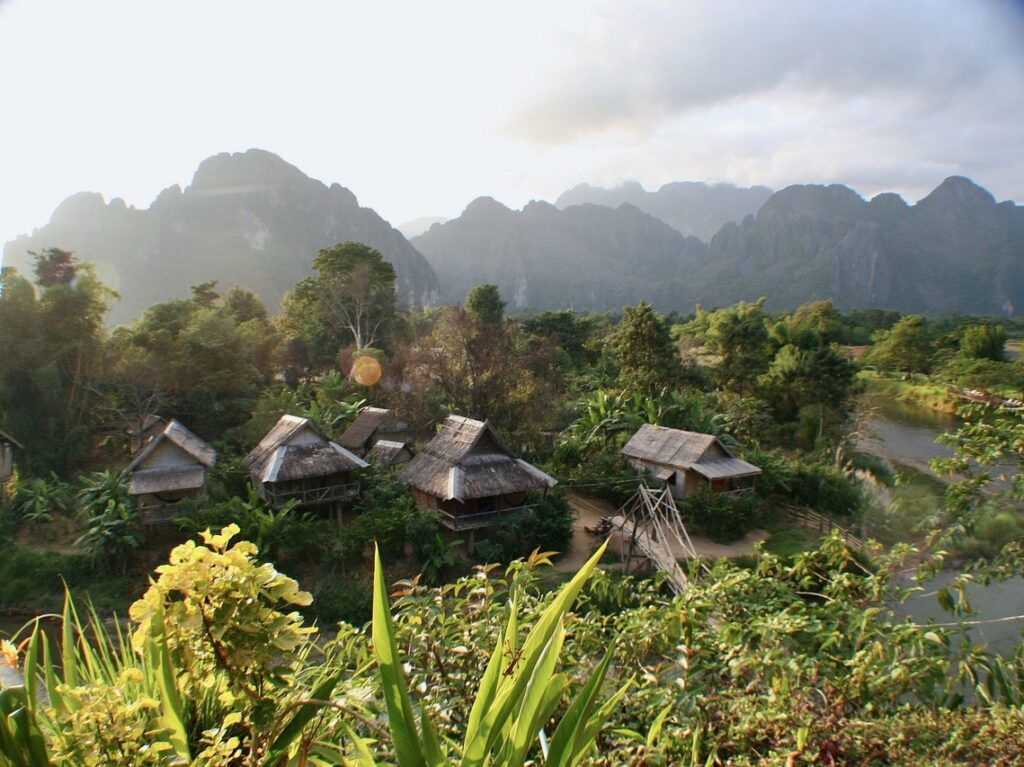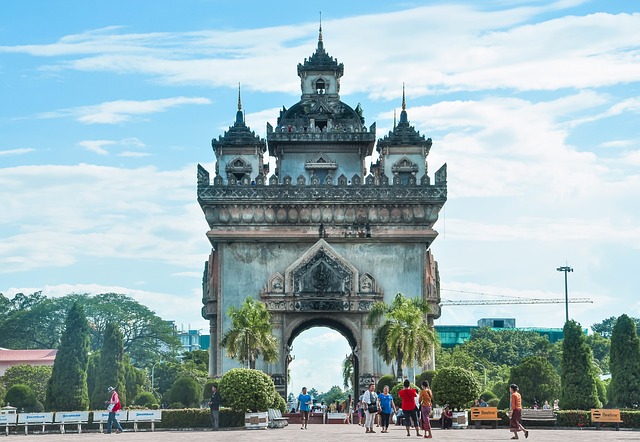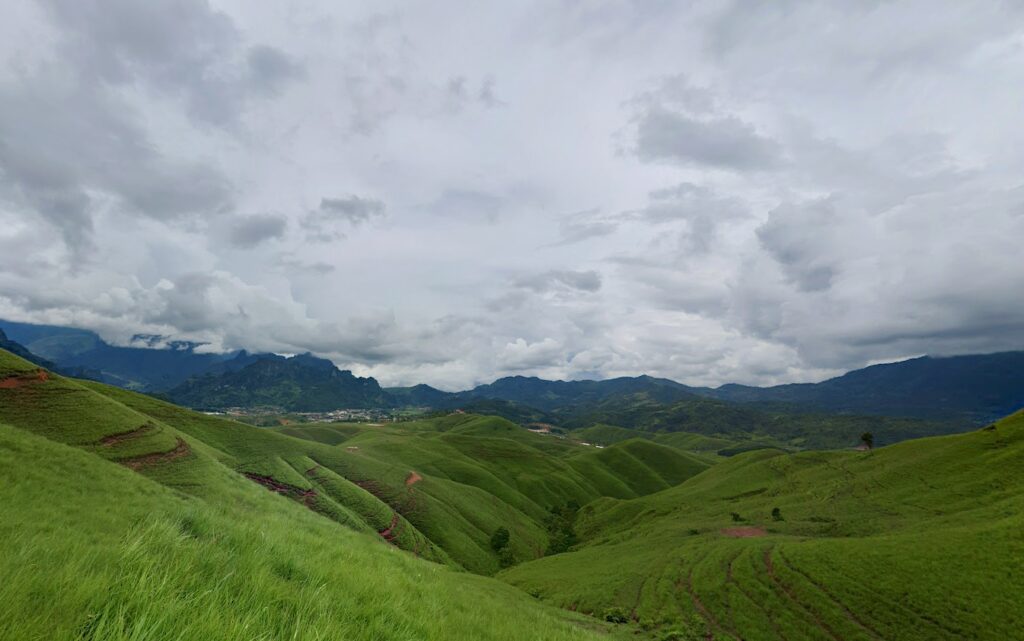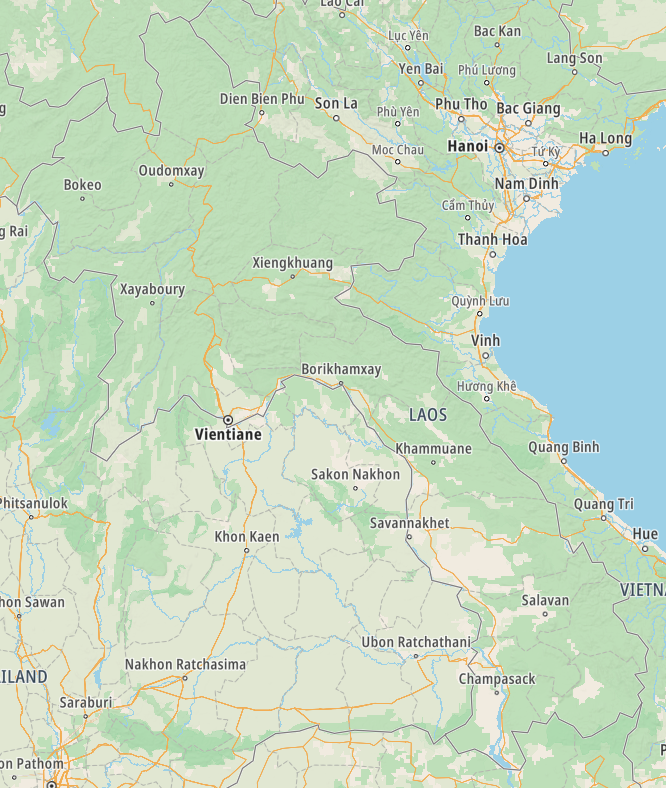Laos / ສາທາລະນະລັດ ປະຊາທິປະໄຕ ປະຊາຊົນລາວ / République démocratique populaire Lao – Let’s explore here

What’s it like in Laos?
Laos is a stunningly beautiful, landlocked country in south east Asia. Of similar size to the the UK, the country mainly consists of forests and mountains, with a few small plains. The highest point is Phou Bia, in the middle of the country, at 9,280 ft (2,830 m) above sea level.
It has a long, rich and troubled history. Its neighbours include Cambodia, China, Myanmar, Thailand and Vietnam.
The population of Laos is around eight million people (2024), about one in ten of whom live in the capital, Vientiane. It has a young population, with almost a third or people being under the age of 15 years.

A bit about the history of Laos
Early History and Kingdoms
Laos has a rich history that dates back to ancient times. The earliest known civilisation in Laos was the kingdom of Lan Xang, which emerged in the 14th century. The name Lan Xang means ‘Land of a Million Elephants’, reflecting the kingdom’s importance and power in the region. Lan Xang was a prosperous kingdom that controlled much of present day Laos, as well as parts of modern day Thailand and Cambodia. The kingdom lasted until the 18th century, when it broke into smaller, warring factions.
French Colonial Rule
In the late 19th century, Laos became a French colony as part of French Indochina. The French sought to control the region for its strategic location and natural resources. Under French rule, Laos underwent significant changes, including the construction of railroads and infrastructure, but the colonial authorities imposed their rule without regard for local traditions and customs. The Lao population faced economic exploitation and social disruption during this period.
Path to Independence
After World War II, a growing nationalist movement in Laos began demanding independence from French colonial rule. Laos officially gained its independence from France on October 22, 1953. However, the country remained politically unstable, with competing factions seeking control. The country’s political turmoil was further fueled by the Cold War rivalry between the United States and the Soviet Union, as well as internal divisions between communist and non-communist factions.
Civil War and the Secret War
In the 1960s and 1970s, Laos was embroiled in a civil war, which was part of the broader context of the Vietnam War. The communist Pathet Lao movement, supported by North Vietnam, fought against the Royal Lao Government, which was backed by the United States. This conflict, often referred to as the Secret War, saw heavy US involvement, particularly in bombing campaigns aimed at disrupting the North Vietnamese supply lines. Laos became one of the most heavily bombed countries in history, with thousands of unexploded bombs still affecting the country today.
Communist Takeover and the Lao People’s Democratic Republic
In 1975, the Pathet Lao successfully took control of the country and established the Lao People’s Democratic Republic. The monarchy was abolished, and the new communist government aligned itself with the Soviet Union and other communist states. The new regime implemented socialist policies, including land redistribution and nationalisation of businesses, but faced significant challenges, including poverty, limited infrastructure and a lack of skilled labour.
Economic Challenges and Development
In the years following the establishment of the Lao People’s Democratic Republic, the country faced significant economic difficulties. The government’s central planning policies were not successful, and the country remained one of the poorest in the world. However, in the 1980s, Laos began to shift towards a more market oriented economy, adopting reforms to encourage foreign investment and privatisation. In the 1990s, Laos joined the Association of Southeast Asian Nations (ASEAN) and began to open up its economy. The country’s economy has gradually improved since then, though it still remains heavily reliant on agriculture, with rice being the primary crop.
Recent Developments and Modern Era
Since the 2000s, Laos has experienced steady economic growth, particularly in sectors such as hydropower, mining and agriculture. However, it still faces challenges, including infrastructure development, poverty and human rights concerns. The government remains tightly controlled by the Lao People’s Revolutionary Party, with limited political freedoms and restrictions on opposition.
Laos has also focused on increasing its ties with neighbouring countries, particularly China, and is involved in regional initiatives such as the Greater Mekong Subregion program. The country’s location along the Mekong River and its role as a transit hub for goods and people in south east Asia has helped bolster its geopolitical importance. The government’s commitment to long term economic development and improving the quality of life for its citizens remains a central focus of its policies.

Laos road trip
We haven’t finished pur planning for driving though Laos yet. When we do though, we’ll post it here, and in the blog.
Hopefully our journey will improve our knowledge of this intriguing and beautiful country, and enable us to meet some interesting people. We’ll be updating this page at that time – don’t forget to check back 🙂
Map of Laos

What’s it like to drive in Laos?
They drive on the right hand side of the road in Laos. In the main, roads are very poor, with many being unsurfaced dirt tracks. Driving standards are also poor.
Do you require an international driving permit in Laos?
We’ve created a dedicated page to driving abroad, which answers this question, and more, which you might find helpful.
Can you use your UK driving license when driving through Laos?
We’ve created a dedicated page to driving abroad, which answers this question, and more, which you might find helpful.
Do I need a carnet de passages to drive in Laos?
We’ve created a dedicated page to driving abroad, which answers this question, and more, which you might find helpful.
What currency do they use in Laos?
In Laos they use the Lao kip, although US dollars and Thai Baht are widely accepted. Cash is widely used. The use of credit / debit cards is not widely accepted. Travellers cheques are not readily accepted. There are many ATMs in cities throughout the country, although less so in more rural areas.
You should make yourself aware of the amount that your bank charges you for using credit and debit cards abroad. Often credit cards are cheaper for purchasing items directly, and for withdrawing cash from ATMs.
What language do they speak in Laos?
They speak Lao, or Laotian, in Laos. french is very widely spoken and English is also widely spoken in cities and tourist areas.
What time zone is Laos in?
Remember, when you’re planning your next trip to take a look at what time zone it’s in.
Do I need a visa to visit Laos?
We’ve created a dedicated, more comprehensive page on visas, which you should find helpful. Check it out!
Is wild camping legal in Laos?
Yes, wild camping is fine in Laos, although make sure the land is not private or used for cultivation of drugs.
What plug / socket type do they use in Laos?
In Laos they use plug / socket types A, B, C, E and F.





Health issues in Laos
Is it safe to drink water in Laos?
No, it is not safe to drink tap water in Laos. Bottled water is readily available throughout the country.
What vaccinations are required for Laos?
This NHS website is kept up to date with all relevant information on vaccinations in Laos.
Phones in Laos
What is the country calling code for Laos?
The country calling code for Laos is +856
What are the emergency phone numbers in Laos?
- The emergency number for police in Laos is: 191
- In Laos, the emergency number for ambulance is: 195
- The emergency number for fire in Laos is: 190
If you’ve got some useful info that you’d like to share, let us know!
And don’t forget to check out all the other pictures!
